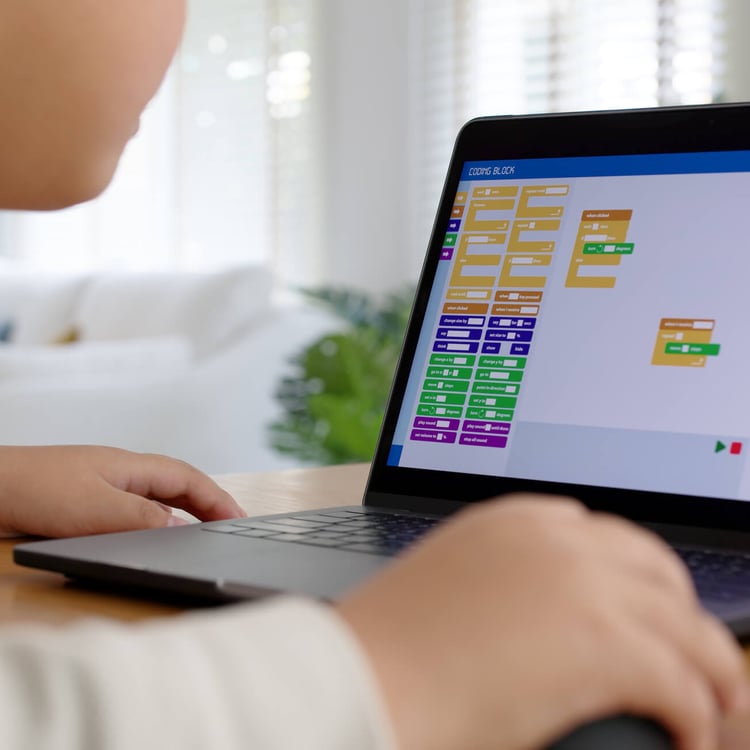Table of Contents
How Coding Games Empowers Kids – Creating Technology Leaders of the Future
This article explores how coding games for kids, a vibrant intersection of play and learning, are not just entertaining but are pivotal in equipping our children with the coding skills they will need in the future. Our journey will explore the essence of coding in today’s world, unveil the educational goldmine that coding games represent, and envisage the role these games play in creating a generation of empowered coders.

How Coding Games for Kids Make Learning Fun and Accessible
Coding games for kids leverage the allure of play to introduce complex coding principles engagingly. By turning lessons into interactive challenges, kids can grasp the basics of coding without feeling overwhelmed.
The concept of gamification in coding education is a game-changer, transforming potential drudgery into a thrilling adventure. Whether it’s navigating through puzzles to learn programming logic or building levels in a game to understand coding sequences, these games are designed to match the learning pace of every child, ensuring that no learner is left behind.
Interactive coding for kids through games ensures that concepts are not just learned but experienced, making abstract programming theories tangible and understandable. This method boosts digital literacy among children, equipping them with the skills to think critically and solve problems efficiently.
Coding games stand out by being extraordinarily child-friendly. With intuitive gameplay, engaging narratives, and compelling visuals, they capture children’s imaginations, making them eager to explore more. This accessibility is crucial for demystifying computer science for the younger generation, encouraging them to delve deeper into the world of STEM without intimidation.
Video:
Popular Coding Games for Kids
In the vast ocean of online resources, several coding games stand out for their effectiveness in introducing programming concepts to children. These platforms not only teach the basics of coding but do so in a way that’s engaging, interactive, and, most importantly, fun. Here are a few popular coding games that have become essential tools in the educational toolkit for budding programmers:
Scratch
Scratch is a free programming language and online community where kids can create their own interactive stories, games, and animations. Its drag-and-drop interface is particularly appealing for beginners, making it a fantastic introduction to the world of coding for kids.

CodaKid
Unlike a traditional learning site, CodaKid specializes in offering online coding courses and coding games that teach kids how to code effectively and enjoyably. With its engaging curriculum that covers real programming languages and professional tools, CodaKid makes learning to code accessible and fun. Kids learn to build their apps, games, and even Minecraft mods, fostering a genuine interest in STEM while nurturing problem-solving skills and creativity.

Tynker
Offering a structured approach to learning coding, Tynker introduces kids to a range of programming languages through game-like lessons. It’s designed to grow with the child, providing more complex challenges as their skills develop.

Kodable
Aimed at the youngest learners, Kodable lays the foundation of coding logic through simple puzzles that teach the basics of programming. Its friendly interface and straightforward challenges make it an excellent entry point into coding for children.

Lightbot
This puzzle game introduces programming concepts like loops and conditionals through problem-solving. It’s designed to build a deep understanding of how coding works, beyond just the syntax, making it a powerful tool for developing problem-solving skills.
Each of these games targets different age groups and learning stages, ensuring that regardless of where a child starts, there’s a platform that can guide them through the fundamentals of programming in a manner that feels more like play than education. Incorporating these games into a child’s learning process can spark an interest in technology and STEM fields, providing a fun and solid foundation for future learning.

Educational Benefits of Coding Games
Coding games offer much more than just entertainment; they serve as a cornerstone for developing a wide array of skills in young learners. These educational tools blend the fun of gaming with serious learning outcomes, engaging children in a way that traditional methods often fail to. Let’s delve into the key educational benefits that make coding games an invaluable part of modern education for kids.
Enhancing Problem-Solving Skills and Logic
One of the most significant benefits of coding games is their ability to enhance problem-solving skills. As children navigate through puzzles and challenges, they learn to think logically and create solutions to overcome obstacles. This not only applies to programming but also helps in developing a mindset that approaches problems methodically, a skill valuable in every aspect of life.
Fostering Creativity and Innovation
Contrary to the stereotype of coding as a rigid and formulaic activity, it is profoundly creative. Coding games encourage kids to experiment, design their games, and bring unique ideas to life. This fosters an environment where creativity flourishes, teaching kids that they can shape their digital world, not just consume it.
Building Digital Literacy
In our technology-driven world, digital literacy is as fundamental as reading and writing. Through coding games, children learn the language of computers. They gain an understanding of how software is created and how technology works, providing them with the tools to navigate and succeed in a digital future.
Promoting Persistence and Resilience
Learning to code, like acquiring any new skill, comes with its challenges. Coding games are designed to present these challenges engagingly, encouraging kids to try different solutions and learn from their mistakes. This promotes persistence and resilience, as children understand that failure is just a step towards finding the right solution.
Preparing for the Future
With the digital economy growing at an unprecedented rate, coding skills are becoming increasingly important. By engaging with coding games, children are not just learning to program; they are preparing for a future where these skills could be essential for their careers. It’s about giving them a head start in the evolving job market, where technology and automation play significant roles.
Related Reading:
- Coding for Kids: The Ultimate Guide for Parents in 2024
- 5 Things that All Kids Should Study to Get a High Paying Job in the Future

Coding Games and STEM Education
Coding games play a pivotal role in the broader context of STEM education (Science, Technology, Engineering, and Mathematics) for children. By weaving programming concepts into the fabric of playful learning, these games act as a catalyst for curiosity in the diverse fields of STEM from an early age. Let’s explore how coding games are not just about learning to code, but are instrumental in shaping well-rounded, future-ready individuals.
Sparking an Interest in Technology and Science
One of the most compelling aspects of coding games is their ability to demystify technology and make it accessible and engaging. Children, driven by their innate curiosity and the joy of gameplay, naturally explore complex concepts in computing and logic. This early exposure lays a solid foundation for a deeper interest in technology and science, fields that are critical to solving the challenges of the future.
Integrating with STEM Learning Pathways
Coding games seamlessly integrate with STEM education by providing a hands-on, interactive experience. Through solving puzzles and building projects, kids apply mathematical concepts and scientific methods in a practical, enjoyable way. This integration helps reinforce the relevance of math and science in real-world applications, making the learning process more meaningful and effective.
Encouraging Problem-Solving and Critical Thinking
At the heart of STEM education is the development of problem-solving and critical thinking skills. Coding games challenge children to think logically, sequence steps, and execute solutions to overcome obstacles. These cognitive processes are essential for all STEM disciplines, equipping young learners with the mental tools necessary to tackle complex problems.
Fostering Creativity in Scientific Inquiry
Contrary to the stereotype of STEM fields as purely analytical, creativity plays a significant role in innovation and discovery. Coding games encourage children to experiment, design, and innovate within the virtual environments they manipulate. This blend of creativity with technical skills highlights the interdisciplinary nature of STEM, where artistic thinking can lead to groundbreaking scientific and technological advancements.
Preparing for a Technology-Driven Future
In an age where technology permeates every aspect of our lives, understanding the principles of coding and computational thinking is invaluable. Coding games not only prepare children for future careers in STEM fields but also equip them with a versatile skill set applicable in a myriad of professional contexts. This preparation is essential for navigating the challenges and opportunities of a rapidly evolving digital world.
By engaging children in the exciting world of programming through play, these games lay down the groundwork for a lifelong interest in science, technology, engineering, and mathematics. They not only cultivate the skills necessary for future success but also inspire the next generation of innovators, problem solvers, and leaders.

Challenges and How to Overcome Them
Introducing children to coding through games is an exciting venture, yet it comes with its set of challenges. These hurdles can range from selecting the right platform to managing screen time effectively. Understanding these challenges and knowing how to address them can help parents and educators create a more enriching learning experience for kids. Here’s how to navigate these waters and turn potential obstacles into opportunities for growth.
Selecting the Right Coding Platform
- Challenge: With an abundance of coding games available, choosing the one that best fits a child’s interests and learning stage can be daunting.
- Solution: Start by assessing the child’s interests, age, and learning style. Platforms like CodaKid offer a wide range of courses that cater to different age groups and interests, making it easier to find a match. Utilize free trials and introductory sessions to gauge engagement and suitability before committing.
Balancing Screen Time
- Challenge: Parents are often concerned about the amount of time children spend in front of screens, especially when it comes to gaming.
- Solution: Set clear boundaries for screen time, ensuring a healthy balance between coding activities, physical play, and rest. Encourage kids to apply their coding knowledge to non-screen activities, such as brainstorming game ideas on paper or building simple robots, to reinforce learning and limit screen exposure.
Keeping Motivation High
- Challenge: Kids may start with enthusiasm but can quickly lose interest if they encounter difficulties or if the game doesn’t meet their expectations.
- Solution: Choose coding games that offer varied levels of difficulty and immediate rewards to keep learners engaged. Celebrate milestones and creations, no matter how small, to boost confidence and motivation. Involvement in a community of young coders, through forums or events, can also provide encouragement and inspiration.
Overcoming the Fear of Failure
- Challenge: The fear of making mistakes can deter children from experimenting and learning effectively through coding games.
- Solution: Foster an environment where failure is seen as a part of the learning process. Highlight stories of successful programmers who learned from their mistakes. Coding games that emphasize creative exploration over right or wrong answers can also help alleviate the pressure to be perfect.
By addressing these challenges with thoughtful solutions, parents and educators can help children navigate the world of coding games more effectively. The key is to be supportive, patient, and proactive in facilitating a learning experience that is not only educational but also fun and rewarding.

Conclusion
In an ever-evolving digital landscape, the need for coding education is undeniable. Whether you’re a parent looking to introduce your child to the basics of programming or an educator seeking to incorporate more STEM activities into your curriculum, the time to act is now. Explore CodaKid, which offers a wide range of coding courses and games designed to make learning accessible and enjoyable. Encourage your children or students to take the first step on this exciting journey, and support them as they explore, learn, and grow.
Let’s not wait for the future to shape us. Instead, let’s shape the future by empowering our children with the skills, creativity, and confidence they need to succeed in a digital world. Engage with coding games today, and watch as the young minds of today become the leading innovators of tomorrow.

















